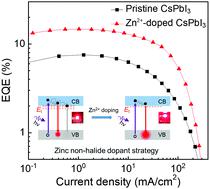当前位置:
X-MOL 学术
›
Mater. Chem. Front.
›
论文详情
Our official English website, www.x-mol.net, welcomes your feedback! (Note: you will need to create a separate account there.)
A zinc non-halide dopant strategy enables efficient perovskite CsPbI3 quantum dot-based light-emitting diodes
Materials Chemistry Frontiers ( IF 7 ) Pub Date : 2020-02-27 , DOI: 10.1039/c9qm00734b Jinhang Li 1, 2, 3, 4 , Jiawei Chen 1, 2, 3, 4 , Leimeng Xu 1, 2, 3, 4 , Sinan Liu 1, 2, 3, 4, 5 , Si Lan 1, 2, 3, 4, 5 , Xiansheng Li 1, 2, 3, 4 , Jizhong Song 1, 2, 3, 4, 6
Materials Chemistry Frontiers ( IF 7 ) Pub Date : 2020-02-27 , DOI: 10.1039/c9qm00734b Jinhang Li 1, 2, 3, 4 , Jiawei Chen 1, 2, 3, 4 , Leimeng Xu 1, 2, 3, 4 , Sinan Liu 1, 2, 3, 4, 5 , Si Lan 1, 2, 3, 4, 5 , Xiansheng Li 1, 2, 3, 4 , Jizhong Song 1, 2, 3, 4, 6
Affiliation

|
Metal ion doping has been considered as one of the most effective methods to achieve highly efficient perovskite light-emitting diodes (LEDs), which is significant for future high-definition displays and high-quality lighting. However, its exact function is still uncertain because the doping of metal ions is also accompanied by the introduction of halide ions and halide-rich circumstances, which can enhance the optoelectronic properties as well. In this work, a zinc non-halide dopant strategy was employed to specifically study the effect of Zn2+ on CsPbI3 quantum dots (QDs). We confirmed that Zn2+ was doped into the perovskites interstitially via X-ray diffraction (XRD) and pair distribution function (PDF) analysis. Zn2+-doped CsPbI3 QDs exhibited higher emission properties with 120% enhancement in the photoluminescence quantum yield (PLQY) compared with pristine CsPbI3 QDs. The Zn2+-doped CsPbI3 QD-based LEDs (QLEDs) showed nearly two-fold increase in the external quantum efficiency (EQE) versus the control device, and it improved from 7.5% to 14.6%. Besides, a maximum current efficiency of 0.83 cd A−1 and the highest luminance of 378 cd m−2 were achieved. These results certify that Zn2+ doping enables high-performance QLEDs without the introduction of halide ions, which is beneficial for the further research on doped perovskite fields and lays the foundation for the future practical applications of QLEDs.
中文翻译:

锌的非卤化物掺杂策略可实现高效钙钛矿CsPbI3量子点基发光二极管
金属离子掺杂被认为是实现高效钙钛矿发光二极管(LED)的最有效方法之一,这对未来的高清显示器和高质量照明至关重要。然而,其确切功能仍不确定,因为金属离子的掺杂还伴随着卤化物离子的引入和富含卤化物的情况,这也可以增强光电性能。在这项工作中,采用了一种非卤化锌掺杂策略来专门研究Zn 2+对CsPbI 3量子点(QDs)的影响。我们证实,通过X射线衍射(XRD)和成对分布函数(PDF)分析,将Zn 2+掺入到钙钛矿中。锌2+与原始的CsPbI 3 QD相比,掺杂CsPbI 3 QDs表现出更高的发射特性,光致发光量子产率(PLQY)提高了120%。Zn 2+掺杂的CsPbI 3 QD基LED(QLED)与控制器件相比,其外部量子效率(EQE)几乎提高了两倍,并且从7.5%提高到14.6%。此外,获得了最大电流效率为0.83 cd A -1和最高亮度为378 cd m -2。这些结果证明了Zn 2+ 掺杂可实现高性能QLED,而无需引入卤离子,这有助于对掺杂钙钛矿领域的进一步研究,并为QLED的未来实际应用奠定了基础。
更新日期:2020-02-27
中文翻译:

锌的非卤化物掺杂策略可实现高效钙钛矿CsPbI3量子点基发光二极管
金属离子掺杂被认为是实现高效钙钛矿发光二极管(LED)的最有效方法之一,这对未来的高清显示器和高质量照明至关重要。然而,其确切功能仍不确定,因为金属离子的掺杂还伴随着卤化物离子的引入和富含卤化物的情况,这也可以增强光电性能。在这项工作中,采用了一种非卤化锌掺杂策略来专门研究Zn 2+对CsPbI 3量子点(QDs)的影响。我们证实,通过X射线衍射(XRD)和成对分布函数(PDF)分析,将Zn 2+掺入到钙钛矿中。锌2+与原始的CsPbI 3 QD相比,掺杂CsPbI 3 QDs表现出更高的发射特性,光致发光量子产率(PLQY)提高了120%。Zn 2+掺杂的CsPbI 3 QD基LED(QLED)与控制器件相比,其外部量子效率(EQE)几乎提高了两倍,并且从7.5%提高到14.6%。此外,获得了最大电流效率为0.83 cd A -1和最高亮度为378 cd m -2。这些结果证明了Zn 2+ 掺杂可实现高性能QLED,而无需引入卤离子,这有助于对掺杂钙钛矿领域的进一步研究,并为QLED的未来实际应用奠定了基础。


























 京公网安备 11010802027423号
京公网安备 11010802027423号